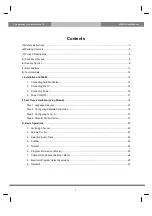
HX400IS
Page 34
9. VHF MARINE CHANNEL ASSIGNMENTS
Tables on the following columns list the VHF Marine Channel assignments for
USA. and International use. Below are listed some data about the charts.
1. VTS. Where indicated, these channels are part of the U.S. Coast Guard’s
Vessel Traffic System.
2. Alpha channel numbers, that is, channel numbers followed by the letter A
(such as Channel 07
A
) are
simplex
channels on the USA. or Canadian
channel assignments whose counterparts in the International assignments
are
duplex
channels. International channels do not use “alpha” numbers. If
you call the Coast Guard on Channel 16, they will sometimes ask you to
“
go to channel 22 Alpha.
” This is a channel assigned to USA, and Cana-
dian Coast Guards for handling distress and other calls. If your radio is set
for
International
operation you will go to Channel 22 instead of 22
A
, and
will not be able to communicate with the Coast Guard. To use Channel
22
A
, your radio must be set for
USA
or
Canada
operation, usually by a U/
I/C (USA/International/Canada) control or combination of controls. Chan-
nel 22 (without an “A”) is an
International
duplex channel for port opera-
tions. Some radios indicate an “A” adjacent to the alpha channels on the
display; on others “alpha” is not indicated but the proper channel is se-
lected based on the U/I/C setting.
3. Bridge-to-Bridge channels (for example, Channel 13) are for use by bridge
operators on inter-coastal waterways and rivers. It is also used by marine
vessels in the vicinity of these bridges for navigation and for communicat-
ing with the bridge operators. Note that a limit of 1 Watt is specified for
these channels.
4. The
S/D
column on the chart indicates either S (simplex) or D (duplex).
Simplex
means transmitting and receiving on the same frequency. Only
one party at a time can talk, unlike a telephone. Be sure to say “
over
” and
release your microphone push-to-talk switch at the end of each transmis-
sion.
Duplex
operation involves the use of one frequency for transmitting
and a separate frequency for receiving. On channels specified as duplex
on the charts, correct mode of operation is established automatically by
your radio when you select a channel; you cannot change the mode. And
you still must release the push-to-talk switch after each transmission in
order to listen to the radio.
5. Channels normally used by recreational boaters are those that include the
term “non-commercial” in the
Channel Use
column of the chart. Some of
these are shared with other users and some are used only in certain geo-
graphic regions.
Summary of Contents for HX400IS
Page 1: ...HX400IS VHF FM Marine Transceiver Owner s Manual ...
Page 11: ...Page 11 HX400IS MEMO ...
Page 31: ...Page 31 HX400IS MEMO ...
Page 43: ...Page 43 HX400IS MEMO ...















































